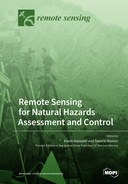Explore

Remote Sensing for Natural Hazards Assessment and Control
0 Ungluers have
Faved this Work
Login to Fave
Each year, natural hazards, such as earthquakes, landslides, avalanches, tsunamis, floods, wildfires, severe storms, and drought, , affect humans worldwide, resulting in deaths, suffering, and economic losses. According to insurance broker Aon, 2010–2019 was the worst decade on record for economic losses due to disasters triggered by natural hazards, amounting to USD 3 trillion, which is USD 1 trillion more than for the period of 2000–2009. In 2019, the economic losses from disasters caused by natural hazards were estimated at over USD 200 billion (UNDRR Annual Report, 2019). In this context, remote sensing shows high potential to provide valuable information, at various spatial and temporal scales, concerning natural processes and their associated risks. The recent advances in remote sensing technologies and analysis, in terms of sensors, platforms, and techniques, are strongly contributing to the development of natural hazards research. With this Special Issue titled “Remote Sensing for Natural Hazards Assessment and Control”, we proposed state-of-the-art research that specifically addresses multiple aspects on the use of remote sensing (RS) for Natural Hazards (NH). The aim was therefore to collect innovative methodologies, expertise, and capabilities to detect, assess, monitor, and model natural hazards. The present Special Issue of Remote Sensing encompasses 18 open access papers presenting scientific studies based on the exploitation of a broad range of RS data and techniques, as well as focusing on a well-assorted sample of NH types.
This book is included in DOAB.
Why read this book? Have your say.
You must be logged in to comment.
Rights Information
Are you the author or publisher of this work? If so, you can claim it as yours by registering as an Unglue.it rights holder.Downloads
This work has been downloaded 83 times via unglue.it ebook links.
- 83 - pdf (CC BY) at Unglue.it.
Keywords
- acoustic gravity waves
- Asaoka method
- ASTER
- Australia
- block adjustment
- burn severity
- burned
- burned area
- burnt area monitoring
- casualty prediction
- climate zones
- convolutional neural network
- coseismic effects
- deep learning
- deformation detection
- digital image correlation
- DInSAR
- displacement mapping
- earth observation
- earthquake
- El Niño
- ENSO
- exponential model
- Extreme climate events
- field line resonance
- Fires
- flash floods
- freeze–thaw processes
- Gaofen-2
- geographic information system
- Geographic Information System (GIS)
- glacier hazards
- glacier instability
- glacier mass balance
- glacier surface energy
- glacier surface velocity
- ground deformation monitoring
- ground motion identification
- Guangdong Province
- hazard
- hazard chain
- heavy rainfall
- hillslope erosion
- ice avalanches
- Identification
- image partition
- importance assessment
- InSAR
- interferometric synthetic aperture radar (InSAR)
- Iran
- K-nearest neighbor
- land subsidence
- Landsat 8
- Landslides
- lithosphere-magnetosphere coupling
- Longchuan County
- machine learning algorithm
- mapping
- Mathematics & science
- meta-heuristics
- mid-resolution sensors
- MODIS
- morphological operator
- MT-InSAR
- Natural Hazards
- optical flow
- permafrost
- phase correlation
- Physics
- PRISMA
- Qilian Mountains
- rainfall erosivity
- random forest
- reclaimed land
- Reference, information & interdisciplinary subjects
- relief
- Remote sensing
- Research & information: general
- Risk assessment
- rock mass strength
- rockfall source areas
- rockfall susceptibility
- RUSLE
- SAR offset tracking
- Satellite Imagery
- Sentinel 2
- Sentinel-1A/B
- Sentinel-2
- settlement prediction
- shallow landslides
- slope angle
- spatial distribution
- spatial division
- spatiotemporal pattern mining
- stacking
- support vector regression
- susceptibility assessment
- suspended sediment detection
- Sydney
- tailing dam risk management
- TERRA
- Time Series Analysis
- time series image stack
- time-series InSAR
- TRIGRS model
- turbidity
- Turpan–Hami basin
- UAS
- Visual analysis
- vulnerability
- wide-area deformation
- wildfire
- Wildfires
- Yan’an city
Links
DOI: 10.3390/books978-3-0365-6833-1Editions

